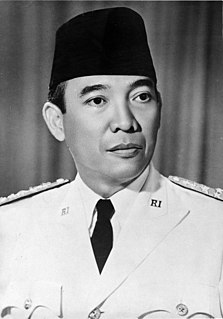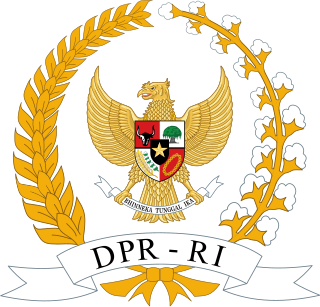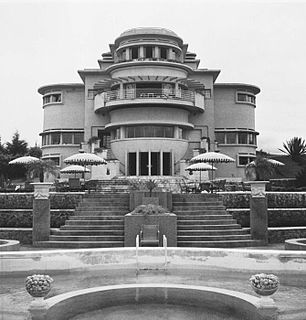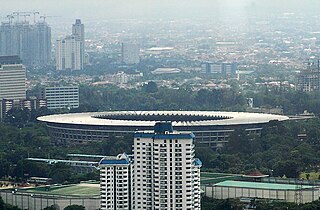
Sukarno was an Indonesian statesman, orator, revolutionary, and nationalist who was the first president of Indonesia, serving from 1945 to 1967.

The People's Representative Councilof the Republic of Indonesia is one of two elected chambers of the People's Consultative Assembly, the national legislature of Indonesia. It is considered as the lower house, while the Regional Representative Council serve as the upper house; while the Indonesian constitution does not explicitly mention the divide, the DPR enjoys more power, privilege, and prestige compared to the DPD.

The Merdeka Palace, is one of six presidential palaces in Indonesia. It is located on the north side of the Merdeka Square in Central Jakarta, Indonesia and is used as the official residence of the president of the Republic of Indonesia.

The Bogor Palace is one of six Presidential Palaces of Indonesia, it is located in the city of Bogor, West Java. The palace is noted for its distinctive architectural and historical features, as well as the adjoining botanical gardens. Istana Bogor was opened to the public in 1968 to public tour groups, with the permission of the acting President of Indonesia, Suharto. The gardens of the palace covers an area of 284,000 square metres.

Menteng is the south-central district of Central Jakarta, one of the administrative municipalities in the capital city Jakarta, Indonesia.

Jakarta is Indonesia's capital and largest city. Located on an estuary of the Ciliwung River, on the northwestern part of Java, the area has long sustained human settlement. Historical evidence from Jakarta dates back to the 4th century CE, when it was a Hindu settlement and port. The city has been sequentially claimed by the Indianized kingdom of Tarumanegara, the Hindu Kingdom of Sunda, the Muslim Sultanate of Banten, and by Dutch, Japanese and Indonesian administrations. The Dutch East Indies built up the area before it was taken during World War II by the Empire of Japan and finally became independent as part of Indonesia.

Bersiap is the name given by the Dutch to a violent and chaotic phase of the Indonesian National Revolution following the end of World War II. The Indonesian word bersiap means 'get ready' or 'be prepared'. The Bersiap period lasted from August 1945 to November 1947. In Indonesia, other terms aside from bersiap are commonly used, such as gedoran in Depok, ngeli in Banten and surrounding West Java, and gegeran and dombreng in Central Java.

Charles Prosper Wolff Schoemaker was a Dutch architect who designed several distinguished Art Deco buildings in Bandung, Indonesia, including the Villa Isola and Hotel Preanger. He has been described as "the Frank Lloyd Wright of Indonesia," and Wright had a considerable influence on Schoemaker's modernist designs. Although he was primarily known as an architect, he was also a painter and sculptor.

Colonial buildings and structures in Jakarta include those that were constructed during the Dutch colonial period of Indonesia. The period succeeded the earlier period when Jakarta, governed by the Sultanate of Banten, were completely eradicated and replaced with a walled city of Batavia. The dominant styles of the colonial period can be divided into three periods: the Dutch Golden Age, the transitional style period, and Dutch modernism. Dutch colonial architecture in Jakarta is apparent in buildings such as houses or villas, churches, civic buildings, and offices, mostly concentrated in the administrative city of Central Jakarta and West Jakarta.

The Jakarta Art Building, historically known as Schouwburg Weltevreden, is a concert hall in Sawah Besar, Central Jakarta, Indonesia, built during the colonial period in Batavia, Dutch East Indies.

Bung Karno Sports Arena, formerly named Senayan Sports Arena from 1969 to 2001 and Asian Games Complex on its early days, is a sports complex located in Gelora, Central Jakarta, Indonesia. It is usually misperceived to be located at Senayan, South Jakarta, hence its former name. The sports complex hosts main stadium, secondary stadium, the Sports Palace, football fields, aquatic stadium, tennis stadiums, hockey, baseball and archery fields, and several indoor gymnasiums. The complex was built in 1960 for the 1962 Asian Games and recently underwent a major reconstruction for the 2018 Asian Games and Asian Para Games.
Kebon Sirih is the northernmost administrative village of Menteng district of Jakarta. It has a postal code of 10340. Kebon Sirih is located to the south of Monas - a historic administrative center of Jakarta - and to the north of Menteng Residential Area - a heritage garden city. The boundary is Jalan KH Wahid Hasyim-Jalan Johar, Jalan Pengarengan to the south, Ciliwung River to the east, Jalan Kebon Sirih to the north, and Jalan Kampung Bali I. 33-Terusan Kebon Sirih 14 to the west.

Jalan M.H. Thamrin or Jalan Thamrin is a major thoroughfare in Jakarta, Indonesia. The road is located at the center of Jakarta, running from the north end of Jalan Jenderal Sudirman at West Flood Canal at the south end to the roundabout near Arjuna Wijaya Statue Jakarta at the north end. Developed in the 1950s, the road was a landmark of post-colonial Indonesia and continues to have a prominent importance in Jakarta.

The Gedung Agung is one of 6 presidential palaces of Indonesia, it is located in the city of Yogyakarta. The palace complex covers an area of approximately 4.4 hectares. It is located in front of Fort Vredeburg.

Gedung Antara is a Dutch colonial landmark in Jakarta. It is located in the vicinity of Pasar Baru area. The building is currently Antara's Institute of Journalism.

Sukarni was an Indonesian freedom fighter and activist who demanded independence for Indonesia during the Dutch colonial era and the Japanese occupation, and was the chairman of the Murba Party until his death.

Pancasila Building is a historic building located in Central Jakarta, Indonesia. The name "Pancasila" refers to the speech delivered by Sukarno in the building on which he explained the concept of Pancasila, a philosophical concept which would be the foundation of the Indonesian nation, on June 1, 1945. Built in the early 1830s, the building is one of the many 19th-century colonial landmarks in Jakarta. The Pancasila Building currently belongs to and is under the preservation of the Indonesian Ministry of Foreign Affairs.
Soejoedi Wirjoatmodjo was an architect in Indonesia who was active during the late 1960s and mid 1970s. In 1964, he was asked by President Sukarno to be in charge as chief architect for national architectural projects in the Jakarta. Soejoedi is considered to be the first native architect of the Post-Colonial period that is considered as a proponent of modernist architects and designers.

Taman Proklamasi is a park complex located in Central Jakarta, Indonesia. The park is located at the former property of Sukarno at what was known as the house at Jalan Pegangsaan Timur 56. The house, now demolished, is where the Proclamation of Indonesian Independence was first read by Sukarno.
The Youth Pledge Museum is a historic museum of the independence struggle of the Republic of Indonesia. It is located in Jalan Kramat Raya No.106, Central Jakarta and managed by the Ministry of Culture and Tourism. This museum is open for public, every Tuesday until Friday from 08.00 until 15.00, every Saturday and Sunday from 08.00-14.00 Western Indonesian Time, and every Monday and national holiday, this museum is closed for public.

















